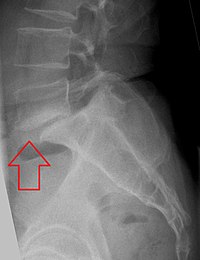
Photo from wikipedia
Objectives (1) Describe the evolution of guideline-endorsed red flags for fracture in patients presenting with low back pain; (2) evaluate agreement between guidelines; and (3) evaluate the extent to which… Click to show full abstract
Objectives (1) Describe the evolution of guideline-endorsed red flags for fracture in patients presenting with low back pain; (2) evaluate agreement between guidelines; and (3) evaluate the extent to which recommendations are accompanied by information on diagnostic accuracy of endorsed red flags. Design Systematic review. Data sources MEDLINE and PubMed, PEDro, CINAHL and EMBASE electronic databases. We also searched in guideline databases, including the National Guideline Clearinghouse and Canadian Medical Association Infobase. Eligibility criteria for selecting studies Evidence-based clinical practice guidelines. Data extraction Two review authors independently extracted the following data: health professional association or society producing guideline, year of publication, the precise wording of endorsed red flag for vertebral fracture, recommendations for diagnostic workup if fracture is suspected, if the guidelines substantiate the recommendation with citation to a primary diagnostic study or diagnostic review, if the guideline provides any diagnostic accuracy data. Results 78 guidelines from 28 countries were included. A total of 12 discrete red flags were reported. The most commonly recommended red flags were older age, use of steroids, trauma and osteoporosis. Regarding the evolution of red flags, older age, trauma and osteoporosis were the first red flags endorsed (in 1994); and previous fracture was the last red flag endorsed (in 2003). Agreement between guidelines in endorsing red flags was only fair; kappa=0.32. Only 9 of the 78 guidelines substantiated their red flag recommendations by research and only nine provided information on diagnostic accuracy. Summary/conclusion The number of red flags endorsed in guidelines to screen for fracture has risen over time; most guidelines do not endorse the same set of red flags and most recommendations are not supported by research or accompanied by diagnostic accuracy data.
Journal Title: British Journal of Sports Medicine
Year Published: 2018
Link to full text (if available)
Share on Social Media: Sign Up to like & get
recommendations!